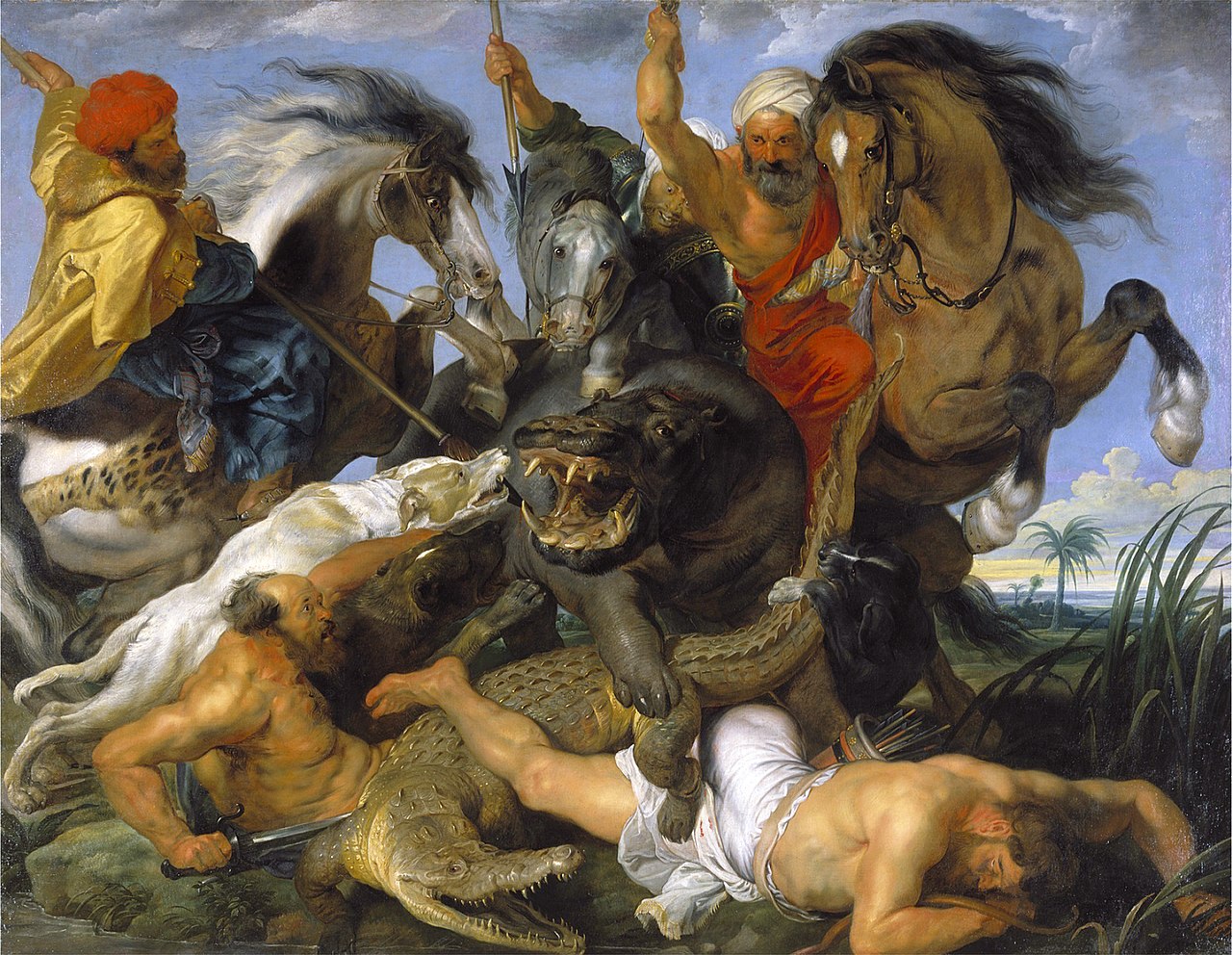Description
The Hunt for the Hippopotamus, also known as Rubens's 'The Hunt for the Hippopotamus and the Crocodile', depicts a furious battle between a hunting party and their prey on the banks of the Nile. Three of the men are portrayed as noblemen tasked with killing the inconvenience. The hippopotamus and crocodile are attacked by three hunters, who ride Arabian horses and brandish spears and swords. His clothing and the palm trees in the background set the scene in Egypt. The painting also shows two valets, one of whom has been murdered. Unlike the hunters, the valets are depicted partially nude. Three hunting dogs are also launching an attack on the beasts.
The Flemish draftsman and painter was known for his hunting scenes, as well as his paintings with religious and mythical themes and themes. Like much of Rubens' work, his hunting paintings displayed frenetic energy and depicted intense scenes. "The Hunt for the Hippopotamus and the Crocodile" also illustrates Rubens' regular use of movement and drama. His colorful and bright palette is also often found in his other paintings. Rubens's hunting scenes were usually painted on large canvases. "Tiger Hunt", a large oil on canvas created between 1615 and 1616, was another of four hunting paintings commissioned by Maximilian I. The other paintings featured wolf and wild boar hunts.
Rubens paints the subjects in "The Hunt for the Hippopotamus and the Crocodile" in striking detail, and the animals are relatively accurate in their appearances. It is believed that he saw a display of a dead hippo before painting the piece. At the same time, the hunt is actually unrealistic and instead represents humanity's struggle with nature. The painting also illustrates contrasts between smooth and scaly textures. He also contrasts beauty through the use of vivid colors and composition with the barbaric and brutal violence on display. Light and dark elements also provide another level of contrast.
"The Hunt for the Hippopotamus and the Crocodile" reflects the currents in and out of the art world at the time Rubens finished the painting. The period saw an increase in natural history. Empiricism and experimental science also gained popularity during the 17th and 18th centuries. Other hunting-related paintings created by Rubens include "Diana Returning from the Hunt" from 1615 and "The Hunt of the Wolf and the Fox" from around 1616. "The Lion Hunt" from 1621 shows two lions attacked by hunters, some on foot and others on horseback. The painting marked the end of Rubens's approach to the subject.
You can thank Italian surgeon Federico Zerenghi for that, as he was the one who brought back a couple of hippo skins from Egypt, stuffed them, and put them on display in Rome and Naples. Coincidentally, Rubens was traveling in Italy at the time. The Hippopotamus and Crocodile Hunt would be one of four paintings depicting hunting scenes commissioned by the Bavarian ruler, Maximilian I. Exotic animals would be quite a gift to a ruler, due to their rarity.
The thing about Zerenghi's stuffed hippo is that it doesn't show exactly what the live hippo looked like. In producing the hippopotamus, the animal lost some of its bulky frame. Because of this, and the fact that Rubens was unfamiliar with this alien species, he had to rely on a few tricks so that no one would figure out that he didn't know what they really looked like. One thing Rubens did was hide most of the hippo's body behind the attacking animals and hunters. What came out was an anatomically correct hippo, but not a life-size hippo; what we have here is a rather small hippopotamus.
This is an action packed painting, fit for any Michael Bay movie. You have the hippo in the focal point being attacked by the hunters and their dogs. At the same time, they are on top of a crocodile that is angrily biting the fallen man on the ground. To make matters worse, the horses the hunters ride will trample anything under them.
This is Rubens' allegory of man versus beast and nature, an intense tumult taking place in an exotic landscape. It is up to you to decide who will win, as Rubens describes only the fight and not the victor.
Rubens was born in 1577 in the city of Siegen when it was part of the Holy Roman Empire. Raised during a time of religious turmoil and the Protestant Reformation, his early life and Catholic upbringing played a significant role in the themes he later exhibited in his art. His early studies focused on the humanist education of the Renaissance, including Latin and classical literature. At the age of 14, Rubens began his artistic apprenticeship in Antwerp. In 1600, he traveled to Italy and became increasingly influenced by the works of Titian and Caravaggio. He also drew inspiration from Veronese and Tintoretto, especially in his style of composition and use of colour. Rubens was also fascinated by Michelangelo, Raphael, and Leonardo da Vinci.
His time in Italy was spent largely in Mantua at the court of Duke Vincenzo I of Gonzaga. Rubens traveled to Venice, Rome, and Florence creating copies of paintings as part of his studies. He also created his first altarpiece, "St. Elena con la Vera Cruz" for Santa Croce in Gerusalemme. The artist also traveled to Spain on behalf of the court. In Genoa, Rubens painted several portraits, including "Marchesa Brigida Spinola-Doria". He also created paintings featuring saints such as Saint Gregory the Great, as well as the Virgin Mary and Jesus.

